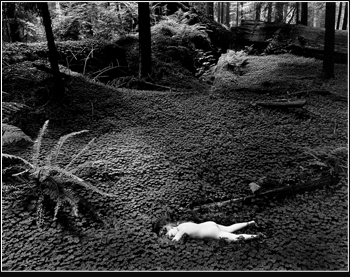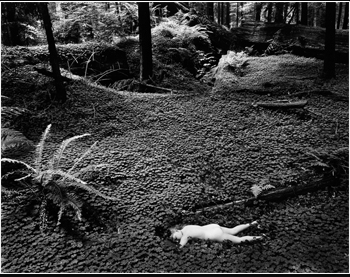 |
|
A CROWN OF FERN
In 2001, however, I was reminded that memory can be selective and that even the most familiar thing can contain a fresh surprise. That year, our family had entered into an agreement with Sarah Morthland and Robert Gurbo of Archival Consulting and Management Services in New York to help us with the Bullock photographic estate. To more thoroughly familiarize himself with the work he would be representing, Robert had been studying his copy of the 1971 Scrimshaw monograph, the first publication devoted to Wynn Bullock imagery. During one of his early visits to California, Robert announced that the more he looked at Child in Forest the more entranced he had become by the crown of fern around my head. It was that small detail he said that made the image particularly special for him. My immediate response was, "What crown of fern!?" Completely mystified, my husband Gene and I took Robert and Sarah into our bedroom where a large framed print of the image was displayed and pointed out that there was no crown of fern. At that point, Robert was non-plussed and asked to see a copy of the Scrimshaw volume. We got it out, found Child in Forest, and sure enough, there was the crown of fern. We surveyed three more monographs as well as The Family of Man book and none had the fern around my head. We then got out the few original prints we had of the image, including one I had given Gene as a birthday present early in our relationship and which Dad later claimed was the best print he had ever made of Child in Forest. It was only this one that had the crown of fern. By this time, our collective curiosity was quite pronounced. I called the Center for Creative Photography in Tucson, Arizona, where Dad's negatives are housed. I described the mystery to Leslie Calmes, the archivist most knowledgeable about Bullock photography and she, as perplexed as we, said she would investigate and get back to us as soon as possible. What she discovered were three "Child in Forest" negatives. In one of them the light was poor and, as far as we know, a print was never made from it. The one designated as "0017B" was identified on the negative sleeve as the one used for the Family of Man show and there was no crown of fern. The third one was "0017A" and noted on the negative sleeve were the words "Family of Man Exhibition - negative too thin". It is in this exposure where the crown of fern is revealed. When we compared the prints and reproductions with this knowledge in hand, we discovered that the small plant of ferns in the middle of the fallen redwood log above my feet was different in "0017B" from the same plant in "0017A". In the former image, the plant had 3 fronds and there was no fern above my head. In the latter image, despite its earlier alphabetic designation, the plant had lost a frond and I had gained a crown. As we pieced the story together, it was obvious that when the exposures were made in 1951, the fern above my head had been an intentional addition. Although I remember much about the day in that beautiful forest, I don't have a specific memory relating to the ferns. It is also clear by the notation on its negative sleeve that Dad had found "0017A" difficult to print and mostly used "0017B". However, there are subtle differences in "0017A" that produce an especially beautiful print when extra time and care are taken in the darkroom. It was this richness and beauty that Dad recognized in the print I had given Gene. Although the 3-frond version of Child in Forest is the one made famous by The Family of Man, the 2-frond print of Gene's is the one we chose to scan for our estate print program. Dad's claim that it was the best print he had ever made of the image was all the guidance we needed. Besides, it has given us a great story to share. ~ Essay by Barbara Bullock-Wilson Copyright © 2015. All Rights Reserved. |
||||||
|
|
|
||
All Content Copyright © 2025 Bullock Family Photography LLC. All rights reserved.

